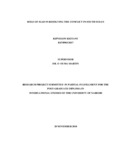| dc.description.abstract | The South Sudan conflict is one of the longest in global history. Right from the independence of Sudan from the British colonial government in 1956, the government of Sudan was overly dominated by Northern Arabs and it entered into an armed conflict with South Sudanese rebels. The conflict lasted up to 2005 when a Comprehensive Peace Agreement was signed. South Sudan attained independence in 2011 but a short two years later, the country was entangled in another civil war this time between factions within South Sudan. The conflict is unresolved to date with IGAD involved in resolving the conflict. However, unlike the approach of international actors, IGAD has pursued a mediation strategy. This study assessed the role of IGAD in resolving the conflict in South Sudan. In this regard, three objectives formed the foundation of the study; the factors behind South Sudan conflict; the role of IGAD in resolving the South Sudan conflict and the challenges facing IGAD in resolving South Sudan conflict. The theoretical foundation of the study is the Ripeness theory as proposed by William Zartman in his study of conflict resolution in studies starting from the 1980s. The Ripeness theory is helpful in identifying the conditions that frustrated or facilitated various agreements that have been reached in South Sudan conflict. Exploratory research design was used to explore the issues related to role of IGAD in resolving the conflict in South Sudan. The study undertook documented review of journal and articles highlighting the role of IGAD in resolving the conflict in South Sudan. The study used secondary data obtained from published works and researches on role of IGAD in resolving the conflict in South Sudan. The study used qualitative data analysis methods to analyze the information gathered from documented review of articles and journals. Findings of the study established that the factors behind the conflict in South Sudan are deeply embedded in the history of Sudan. In addition, racism, religious fanaticism and political and economic discrimination of people of South Sudan have been propagated by the government in Khartoum. The main factors behind the conflict in South Sudan may thus be summarized as; marginalization through religious and economic lines, political and economic factors and contribution of Sudan People‟s Liberation Movement (SPLM). The study established that IGAD has escalated the use of mediation in resolving the conflict in South Sudan. IGAD was successful in mediation efforts since it led to end of the violent conflict between South Sudan rebels and the Government of Sudan. The agreement paved way for South Sudan‟s referendum. The civil war that had lasted for over 20 years between South and North Sudan came to an end. Eventually, South Sudan conducted a referendum on July 9, 2011 that resulted to South Sudan being declared an independent nation. The study established that the challenges facing IGAD in mediation of the conflict in South Sudan emanated from the fact that conflict was a very complex one. The study recommended that understanding the factors behind the South Sudan conflict is crucial in establishing the genesis of the conflict and possible solutions to the conflict. The study recommends that IGAD should be accorded the mandate of using the East Africa Standby Force (EASF) to enforce the resolutions and agreements made | en_US |



